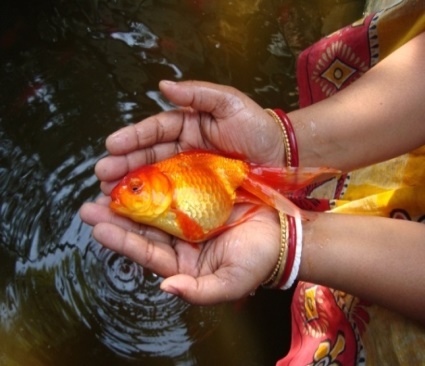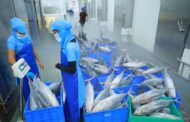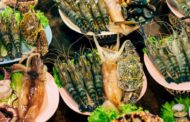Dr. Archana Sinha
Ornamental fish trade is an important sector for livelihood generation in India. Apart from employment generation, Ornamental fisheries contribute to the women empowerment and foreign exchange earnings. It has vast opportunities, low investment and less water requirement.
The usual criteria of the fish to be classified under ornamental fish are attractive look with beautiful colouration, adaptability to live in small confined areas, peaceful nature and compatibility to live with other fishes like gold fish, angel fish, guppy, discus, tetra, gourami, etc.
Like any other trades, growth of ornamental fish trade also depends on viable technology, best management practices, market and infrastructure.A lucrative export market and high domestic demand has made ornamental fish industry a potential source for income generation in India. But, in spite of the fact that the country possesses rich diversity of ornamental fishes, India is lagging behind in ornamental fish export and its overall contribution to global export remains only Rs. 8.4 crores (0.32%).
Indian exports mainly target South East Asia, China, Middle East, EU, USA and Japan. The major part of the export trade is based on wild collection from NEH. Out of 250 indigenous ornamental fish species, 155 fish species are being regularly exported and many fish species are also having very high potential.
Domestic market
There is a huge domestic market in India, worth about Rs.555 crores with an estimated potential of Rs.5000 crores. Indian domestic trade in ornamental fish is growing @ 20% annually and demand at domestic level is higher than supply. Agro climatic conditions of all the states of the country are suitable for ornamental fish breeding and culture however,these activities are concentrated to a few states especially in West Bengal (55%), Tamil Nadu (35%), Kerala( 5%), North East states (7%), Maharashtra (3%) and a few in Madhya Pradesh,Rajasthan and Uttar Pradesh.
MPEDA, Kochi has prepared a directory of ornamental fish exporters in which they have identified 25 ornamental fish exporters in India especially, in Kolkata, Mumbai, Chennai and Kochi. India is known in International ornamental fish trade for its wild caught fish. Ornamental fish entrepreneurs can grab the opportunity by rearing indigenous ornamental fish which are of high demand in the international trade. Faith in Vastu as well as tourism development also accelerated the growth of the trade.
Breeding and rearing
Ornamental fish trade includes breeding, rearing, live food collection and culture, feed preparation, aquarium plant propagation and trade, accessories and decorative toys preparation, aquarium making and marketing. As per an estimate a hobbyist spends 20% on fish, 63% on aquarium and accessories, 11% servicing and 6% on feed. Therefore, industry should not concentrate only on fish but also give attention to the ancillary activities.
The profit of ornamental breeding and rearing unit depends upon the carrying capacity, candidate species, management practices and infrastructure. Kolkata ranks first position not only in export trade but also this city and its suburbs have significant contributions in domestic field in fish trading as well as ornamental fish farming.
As Kolkata airport is the gateway for export trade but on the other Howrah railway station performs as the transit point for sending consignments of such pet fishes by trains to distant places like Delhi, Jaipur, Ahmadabad, Chennai, Mumbai and Bhopal. Such consignments of aquarium fishes, sometimes, are also airlifted for Bangalore, Chennai, Delhi, Dehradun and Ludhiana etc.
There is a unique relationship of supply and demand of the aquarium fish and aquarium accessories. Unlike, other trade, the demand increases if the supply is more. More supply attracts more hobbyists and demand increases accordingly and finally supply flow increased.
The largest and the oldest pet market not only in Kolkata but also in India is a unique Sunday pet market in the Galiff Street, also known as the “BagbazarSokher (Hobby) Haat”. It starts every Sunday in early morning and ends by late afternoon, remains fully functional and flooded with customers. The street offers a different variety of rabbits, albino rats, guinea pigs, dogs, ornamental fishes, birds, flowers and plants of exotic and rare varieties.
It is essential to focus on developing a value chain approach from seed collection, culture and export of various ornamental varieties by ensuring environmental and socioeconomic sustainability, product quality and overseas access to the ornamental fish industry in India. In India, despite many initiatives by the government, the ornamental fisheries remain highly unorganized, and this results in extended marketing channels which cause marginalization of the producer. The value chain for ornamental fish in the country is rather short.
Collectors (Get negligible Price)—UNREGISTERED SMALL TRADER (Get Rs.20-50 /-per piece)—WHOLESELER (Get Rs.30-100 /-per piece)—EXPORTERS (Get Rs.50-1000/- per piece)
Government intervention
Agencies like Marine Product Export Development Authority (MPEDA), National Fisheries Development Board (NFDB), National Cooperative Development Cooperation (NCDC) and National Bank of Agricultural and Rural Development (NABARD) are taking keen interest in promoting the development and culture of ornamental fishes and so far various activities are being taken up in different regions of the country where the prospects of ornamental fisheries are high.
Encouragement of the producers, fish collectors, entrepreneurs and other stakeholders of the ornamental fisheries sector through different governmental agencies may help to bring up new possibilities to reach the level comparable to other advanced exporting countries in the near future.
The country needs to build capacity for certification, quarantine, quality control and other regulatory processes on ornamental fish. Separate certification guidelines and quarantine facilities are required for ornamentals. Health certification process need to be simplified and may be arranged through quarantine monitoring authority. Registration of the full value chain including collectors, traders, importers and exporters is needed and preferably the respective state fisheries departments should be accredited with the responsibility to issue registration certificates.
The skill development in this sector is the need of the day. Providing training to fabricate simple glass aquarium and earning between Rs.1200- 2000 for livelihood is not now advisable. Now the trend is changing and the cost of a biotope aquarium starts from Rs. 1-2 lakh.
To frame a national policy for ornamental fish culture development trade, following points must be taken care of-
- Collectivization of small units is a good tool for the domestic producers to face stiff competition from importers
- Forming a corporate entity is worth emulating in order to encourage, develop and nurture Farmers Producers Organizations (FPOs) in the country
- Government assistance and incentives should also be extended to machinery/infrastructure used for manufacturing the ornamental fish culture accessories.
- Develop breeding technologies for high value indigenous ornamental fish species and ensure quality fish seeds in bulk quantities.
- Development of new technologies for an uninterrupted supply of live feeds and advanced disease diagnosis and treatment mechanism.
- Identification of natural breeding grounds of commercially important ornamental fish and declaration as sanctuaries.
- Appropriate regulations to facilitate green growth by increasing trade in products certified for sustainability and promoting certification-related services in international supply chains.
- Skill development of qualified youth for ornamental fisheries development.
- Creation of awareness to raise number of hobbyists of ornamental fish and strengthen stakeholder linkages.
Ancillary industry A wide variety of pumps, air stones, filters, heaters, thermostats, assorted electrical gadgets, nets, tubes, buckets, are a prerequisite even for setting a home aquarium. Besides decoration pieces, molluscan shells, sand and gravel and a wide variety of beautiful artificial or natural aquatic plants like Cryptocome, Echinodorus, Elodea, Hydrophyla, Ludwigia, Cabomba, Myriophyllum, Vallisneria, etc. are options for trading. In aqua-escaping, different aquarium plants of suitable varieties are arranged in a harmonious way to create an aesthetic finish. There is need to have live food organisms or culture them and commercial or home-made feeds for the fish.
There is huge demand of service provider in aquarium keeping and maintenance especially in metro and major cities. An efficient service provider can attend 3-4 such calls and can earn Rs. 1000-2000 per day. However, there is scarcity of such providers.
Government of India has initiated Skill Development Programme and providing certificate after completion of the training as technically Skilled Ornamental fish technician. This degree is valuable and they can provide technical services to individual and public aquaria. A skilled person having NSDC certification can earn without any investment.
Certainly, the success of aquarium fish trade also depends on qualifications and skill of the trader. But, it is observed that highest percentage of ornamental fish producers have minimum education, though there are a few who are graduates and postgraduates also. But, now there is a positive sign showing the development of business as the technically qualified people from engineering sector, IT sector, MBA in addition to the fisheries professionals are joining the trade. Entry of qualified youth, skill enhancement, innovative products and well informed hobbyists are the key indicators of the progress of the business.
In India, the ornamental fish trade is started very late in comparison to other countries involved in ornamental fish marketing. Now popularity to keep aquarium in houses is increasing day by day. The factors like increase in income of middle class group, prevailing nuclear family, believe in Vastu are responsible to attract the hobby. The demand of hobbyists is also changing gradually. Garden ponds are coming as aninnovative hobby.
Many garden ponds and home improvement stores are featuring a variety of equipment for homeowners. Pre-formed ponds as well as dug and lined ponds bring together various segments of landscaping with the use of stones, filters, pumps, lights, fish, and aquatic plants to provide attractive features. Fisheries professional have qualifications and they better understand about the fish behaviour, water chemistry and feed requirement. They have expertiseto rear the fish in small captive ponds. They can grab this opportunity to earn more money as there are very few such experts in the country. They can develop their own design of garden ponds and roof ponds and also provide maintenance services to the clients. They can accept online orders and flourish their business.
Surprisingly, there are very few entrepreneurs who are preparing medicines and chemicals for maintaining the fish health. As the ornamental fishes are being kept in captive conditions in small aquarium, chances to encounter diseases is very high. There is demand of chemicals and medicines for the prophylactic treatment and disease control of the ornamental fish.
In most of the shopping malls in major and metro cities, now a day’s one can see fish pedicure spa. It is nothing but cleaning the dead skin by small fish called doctor fish, Garrarufa(doctor fish), it is a fish originates in the river basins of the Northern and Central Middle East, mainly in Turkey, Syria, Iraq and Iran. A similar fish Garradactylais of Indian origin and can be studied for the spa. A considerable change is observed in the life style of Indians. Such type of pedicure is already in demand. A customer pays Rs. 100-200 per hour. An awareness and skill development to start such spa will certainly help and provide employment.
Conclusion
Increasing volumes of trade without appropriate policy support can have adverse consequences, such as pressure on natural resources, extraction for production, processing, and social marginalization. Global ornamental fish market depends on market forecast, production and consumption, import-export analysis, business attractiveness, type and application analysis, competitive landscape, industry analysis, raw material analysis, marketing and distribution strategy.
(The author is Principal Scientist, ICAR-CIFRI, Barrackpore, Kolkata (W.B.). Views expressed are personal.)
(Please share your experience, interesting news articles and case studies at aquapostnews@gmail.com)






